(1979). Social Networks and Psychology. Connections, 2 - INSNA
(1979). Social Networks and Psychology. Connections, 2 - INSNA
(1979). Social Networks and Psychology. Connections, 2 - INSNA
You also want an ePaper? Increase the reach of your titles
YUMPU automatically turns print PDFs into web optimized ePapers that Google loves.
- 120 -SMITH, Christopher J . (Oklahoma) . "Self-Help <strong>and</strong> <strong>Social</strong> <strong>Networks</strong> in the Urban Community ." Ekistics 268(March-April, 1978) : 106-225 .This paper recommends an alternative orientation for geographers, anthropologists, sociologists <strong>and</strong>others interested in applied social <strong>and</strong> urban issues . Instead of studying problems, particularly theirincidence <strong>and</strong> their spatial distribution, it suggests that at least some emphasis be placed on nonproblembehavior, <strong>and</strong> on the positive helping that occurs daily in a multitude of self-help groups <strong>and</strong> lay socialnetworks within the urban community . To illustrate the importance <strong>and</strong> the functioning of social networks,one group of urban dwellers, recent rural-to-urban migrants, was selected for a conceptual case study . Inadapting to city living, migrants face unusually severe problems . They must quickly establish a network ofsupportive people, service, goods, <strong>and</strong> information - to draw upon in times of need . Migration is just oneurban situation to which a study of social networks can be applied . Although urban analysts will be arrivingsomewhat late on the social networks scene, many research questions remain unanswered, for example : Whohelps <strong>and</strong> who is helped? How is information circulated from those who are providing to those who are inneed? Where do the helpers <strong>and</strong> the helpees live in relation to one another? How do distance, relativelocation, <strong>and</strong> migration affect the operation of the helping network <strong>and</strong> the overall strength <strong>and</strong> cohesivenessof ties?Unhappily, in spite of all the research conducted on social problems, relatively little is known aboutwhy they occur <strong>and</strong> why they occur where they do . We have little to lose, therefore, by recommending thatsome within our ranks begin to ask why problems do not occur in certain places . Geographers will probablycontinue to map the distribution of social problems occurring in urban communities . Unfortunately, theirresearch efforts too often stop there, perhaps, at best, with a recommendation that help, or more oftenmoney <strong>and</strong> other tangible resources, should be channeled into the problem-rich, service-poor neighbourhoodsof the city . Too often such deterministic spatial planning fails because we know very little about thebehaviors of people experiencing problems on a day to day basis, <strong>and</strong> about the way they search out <strong>and</strong> usethe naturally occurring helping networks within their community . This paper suggests some avenues thatresearchers might travel along in the search for such knowledge (excerpts from paper) .SORENSEN, Aage B . (Sociology, Oslo <strong>and</strong> Wisconsin-Madison) "Career Patterns <strong>and</strong> Job Mobility" Paper presentedat a conference on "Mathematical Models of <strong>Social</strong> Change" Bad Hamburg ., West Germany, March, <strong>1979</strong> .This paper has attempted to investigate a measure of the opportunities for gains in attainment providedby the vacancy competition model of the attainment process . Black white comparison was used to validatethis measure . The vacancy competition model provides predictions both for the dependence of the rate ofjob mobility on time in the labor force <strong>and</strong> for the dependency of the rates on the discrepancy betweenpersonal resources <strong>and</strong> current attainment levels . In both instances the main parameter of interest in theempirical analysis is the measure of the opportunity structure suggested by the model .The investigation of the relation between time in the labor force <strong>and</strong> the rate of moves did notprovide support for the theory . However, rather than attributing this to a fundamental defect of the theory,it was argued that the presence of irregular careers not accounted for by the theory makes time in thelabor force a poor measure of the forces that generate job mobility in the vacancy competition model . Adirect investigation of these forces justifies this argument . The dependence of the rate of upward moveson the resources of persons <strong>and</strong> their attainment level provided clear support for the existence of theunequal opportunity structures for blacks <strong>and</strong> whites as measured by the parameter b of the vacancy competititionmodel . The opportunities for upward moves are more constrained by the current attainment level forblacks than it is for whites . Also, it was found that blacks have higher risks of demotions than do whites .VERBRUGGE, Lois M . (Biostatistics, U . Michigan) ."Adult Friendship Contact : A Dyadic Model ." UnpublishedPaper . January, <strong>1979</strong> .Close friends enjoy seeing each other . How often they actually get together is affected by each person'stime constraints <strong>and</strong> his/her preferences for use of leisure time . These constraints <strong>and</strong> preferencesvary among social <strong>and</strong> demographic groups . This paper examines variations in contact frequency with closefriends for sociodemographic groups, relying on the concept of time-budgets to develop hypotheses <strong>and</strong> interpretresults . Two surveys of adult friendships are used ; in both, respondents (egos) were asked to nametheir three closest friends (alters) . Dyadic models which contain both ego <strong>and</strong> alter characteristics aspredictors are estimated . The main results are : (1) Age, marital status, sex-marital status, <strong>and</strong> occupationhave the strongest effects on contact frequency, reflecting the time commitments <strong>and</strong> leisure preferencesassociated with those positions . (2) The patterns <strong>and</strong> size of effects are similar for egos <strong>and</strong> alters .(3) Friends who are similar in marital status, sex-marital status, <strong>and</strong> political preference see each othermore than friends who are dissimilar . But for several attributes, dissimilarity enhances contact, suggestingthat complementary experiences <strong>and</strong> attitudes are sometimes attractive . Keeping the time-budget perspective,several other predictors (residential proximity, degree of affect, <strong>and</strong> duration of acquaintance)are examined . Finally, these results about friendship behavior (contact frequency) are compared withresults about friendship structure, <strong>and</strong> the importance of time-budgets for predicting contact with lessclosefriends <strong>and</strong> acquaintances is discussed .
















